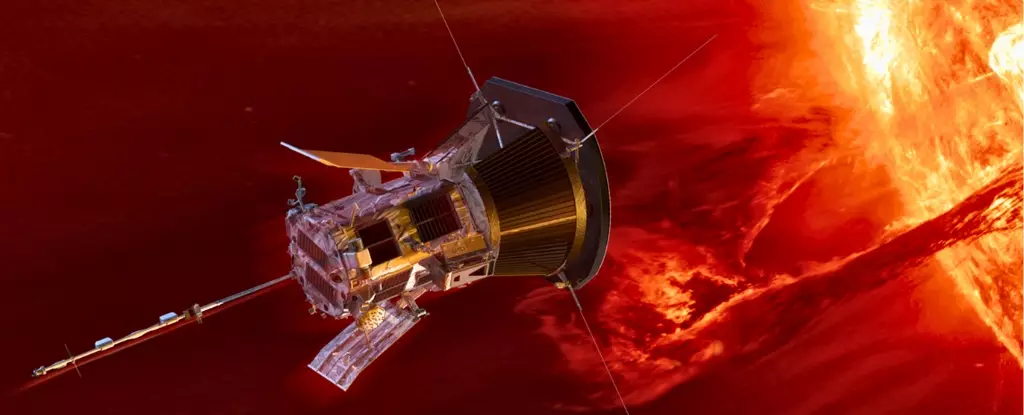Launched in August 2018, NASA’s Parker Solar Probe (PSP) embarked on an unprecedented mission to unveil the mysteries of the Sun’s outer atmosphere or corona. With a design focused on testing the limits of solar exploration, the probe aims to push through the boundaries of our understanding of solar dynamics and its effects on the solar system, particularly regarding space weather. The program was born from decades of ambition, following initial proposals as early as 1958, and has since evolved into a groundbreaking success.
The Parker Solar Probe has set spectacular records since its launch. On October 29, 2018, it claimed the title of the closest human-made object to the Sun by exceeding the proximity set by Helios 2. This achievement was the result of meticulously planned gravity assists from Venus, which allowed the probe to spiral inward towards the Sun gradually. The PSP’s trajectory places it in an elliptical orbit, bringing it nearer to the Sun with each pass, ultimately aiming for a jaw-dropping approach of just 6 million kilometers (3.8 million miles) above the solar surface on December 24, 2024. This is an infinitesimal distance, about 0.04 AU— signifying the monumental nature of this mission.
One of the most astonishing characteristics of the Parker Solar Probe is its speed. Passing through the solar atmosphere at approximately 692,000 km/h (430,000 mph)—or about 0.064% the speed of light—PSP is now recognized as the fastest human-made object ever constructed. This incredible velocity is essential for the probe to gather critical data during its close encounters, enabling comprehensive studies of solar phenomena, such as solar wind.
To withstand the scorching temperatures of the corona, which can range between 980 and 1425 °C (1,800 to 2,600 °F), the Parker Solar Probe is equipped with a state-of-the-art carbon foam heat shield. This technology not only protects the spacecraft from the debilitating heat but also ensures that its scientific instruments remain cool and functional. The prowess of this heat shield is a testimony to the advanced engineering and innovation that has gone into crafting a machine resilient enough to navigate the harshest environment known to humanity.
The scientific objectives are aimed at fostering a greater comprehension of the Sun’s behavior and its influence on space weather, which has far-reaching consequences for Earth and its technological infrastructure. Each flyby of the Sun adds to our understanding of solar wind dynamics, vacuum processes, and even unforeseen phenomena like the peculiar switchbacks in solar wind observed during earlier passes. The data collected will enrich our understanding of how solar activity affects both local and distant celestial bodies.
Nour Rawafi, the project’s lead scientist, emphasized the significance of their findings, stating that the probe is heralding a new era of exploration, “bringing us closer than ever to unlocking the Sun’s deepest and most enduring mysteries.” This sentiment is echoed across the scientific community as researchers wait eagerly for the wealth of knowledge that lies ahead.
The Parker Solar Probe is not merely a one-dimensional mission. Previous encounters with Venus have propelled the spacecraft toward new astrophysical insights, including capturing the first complete images of the planet’s orbital dust ring. Moreover, the probe has provided data on the interaction between solar activity and planetary atmospheres. Adam Szabo, the mission scientist, noted that the close approaches promise to yield fresh insights into solar wind acceleration—key to understanding its dynamics and interstellar impacts.
As the Parker Solar Probe gears up for its next solar encounters planned for March and June 2025, there is palpable excitement among scientists and researchers. The probe’s commitment to pushing the boundaries of what we know about the Sun promises to uncover not only the fundamental processes governing stellar behavior but also the intricate connections that exist within our solar system.
The Parker Solar Probe embodies the spirit of exploration and discovery that drives humanity to reach for the unfathomable. By delving into the heart of the Sun, this mission not only enhances our scientific arsenal but also fortifies our understanding of how solar activity influences our existence on Earth. As we await the arrival of new data, one thing remains clear: the journey of the Parker Solar Probe marks a pivotal moment in solar science—one that may very well illuminate secrets of the cosmos for generations to come.


Leave a Reply